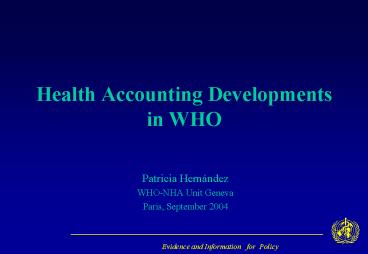Health Accounting Developments in WHO - PowerPoint PPT Presentation
Title:
Health Accounting Developments in WHO
Description:
Introduction of an agenda centered basic expenditure & financing concepts ... Officious translation in Mongolian, and several other languages. ... – PowerPoint PPT presentation
Number of Views:19
Avg rating:3.0/5.0
Title: Health Accounting Developments in WHO
1
Health Accounting Developments in WHO
- Patricia Hernández
- WHO-NHA Unit Geneva
- Paris, September 2004
2
A young project in the institutionObjectives
(1999-)
- Introduction of an agenda centered basic
expenditure financing concepts - A framework based on available experience with an
incremental approach to expand and refine the
methodology - Creation of a database collating all entries
published by each country but converging towards
a homogeneous reporting system - Activities include capacity building, technical
advice, specialized communication and validation
procedures - Identification of country-specific problems and
generation of country-specific solutions
3
The core activity Proto-accounting Report of
Financing Agents
- Designed to promote the measurement of resources
assigned to health in Member States, with
emphasis on quantifying the purchasing
transactions - A Best estimates approach
- Emphasis placed on official data, on primary
records and on a validation procedure - NA type adjustments of a statistical, conceptual,
exhaustiveness balancing nature - A permanent updating procedure when better
sources available - An active search of validation agents
- national entities, HA, NA financing experts,
international organizations (WB, CARICOM, etc.),
HA networks (Shared Alliance, APNHAN, etc.), use
of the decentralized WHO structures (RO, WR),
etc.
4
Indicators in the public domain
- 192 Member States
- of which 105 have validated the level of their
estimates - 70 countries have at least one NHA estimate
- Three quarters have some basic functional
government finance indicators - Over a half have a household survey
- Coverage for 1995-2001. Updating 1998-2002 to be
released in 2005 - Includes ratios and per capita levels of main
aggregates and Financing Agents - Main outlets
- World Health Report, WHO website
(www.who.int/nha), Regional Offices Reports - WB-WDI, UNDP/HDR, several ECOSOC entities
5
A Global Public Good
- Easy access
- Wide geopolitical coverage
- Best estimate to date. In terms of conceptual,
methodological information advances,
progressive quality control improvement - Sources and methods transparent
- Contribution to increase the awareness of the
amount of health resources in Member States - First release in June 2000, annual updates
- Response to specific requests
- WHO Outside (UNAIDS, WB, UNRWA, EIU, BBC, The
Economist, ..)
6
Capacity building
- Guide to Producing NHA (WB-WHO-USAID PG, 2003)
- PG to be published in Russian and in Spanish,
programmed in French. Sumary in Arabic by EMRO.
Officious translation in Mongolian, and several
other languages. - A supplement in preparation to generate
distribution of resources among population
groups, by geopolitical entities, by demographic
characteristics, by disease and interventions and
by socioeconomic conditions - Preparation of methodological material on
implementation issues focusing mainly on private
spending and on external resource measurement
(currently fairly aggregate estimates) - The WHO web-site facilitates the discussion of
country specific problems to HA building by way
of an Expert Panel - Technical material made available to consultants
and organizations working on capacity building
7
Capacity Building within WHO
- Country specific technical visits China, India,
Namibia, Togo - Technical exchanges with some 50 NHGA developers
in countries Vietnam, Samoa, Suriname, Chad,
Chile, Uruguay, Ecuador, Iran, Algeria, etc - Support to networks Francophone Africa CIS
countries APNHAN Eastern, Central and Southern
Africa networks EMRO Shared Alliance, AMR. - NHA training courses support of technical
events - Global attendance NHA sessions in Bali, South
Africa, Crete - Regional Workshops
- through the regional offices EURO, AFRO, EMRO and
PAHO - HQ staff provided training for CEE/CIS workshops,
Francophone Africa, EMRO, SEARO, AMRO, WPRO - Country Workshops India
8
Harmonization of Expenditure on Health Reporting
- Expenditure on health in websites of Regional WHO
offices - Global Resource Tracking Blueprint initiative by
the Gates Foundation/CGD - HIV/AIDS and NAA
- Malaria
- IVB and GAVI sustainability analysis
- Social Security (ILO)
- Resources for Research
- Pharmaceutical expenditure first release for 180
Member States The Drug Situation in the World,
2004 financing chapter annex table - OECD Partnerships
- Formal agreement for reporting OECD aggregates in
the World Health Report - External funding data from OECD/DAC
9
- How much is spent on health in Member States?
- How do health systems perform?
- Have been the WHO concerns in 1998-2000.
- Related measures released in June 2000
- Fairness of contribution financing sources
- Pooling strategies financing agents
- Services purchased provision and functions
- Effectiveness and efficiency spending vs. health
outcomes
10
Updating tasks
- How much is spent on health in the whole world?
- Who pays for it?
- On what is it spent?
- On whom is it spent?
- Who benefits?
11
Analytical framework of health accounting
resource flows Existing schemes
Resource flows potentially to be monitored by
WHO-HQ
SHA
LAC other regional experiences
Financing Sources
Financial Agents Production Cost
of production factors
Providers Consumption Health services
(Functions) Beneficiaries
Financing Financial Agents (Sources of
funding) Production Providers
Consumption Health services (Functions)
Beneficiaries
Financing Sources
Financial Agents Production Cost of
production factors Providers Consumption
Health services (Functions) Beneficiaries
Beneficiaries
Trade, Employment, Prices ICHA
Beneficiaries Changes in level and distribution
of health stock Geopolitical subnational
entities, Demographic socio-economic
characteristics Apparent health needs and
interventions
Beneficiaries Geopolitical subnational entities
(county), Socio-economic characteristics
Apparent health needs and interventions
Beneficiaries Demographic characteristics
Apparent health needs and interventions































